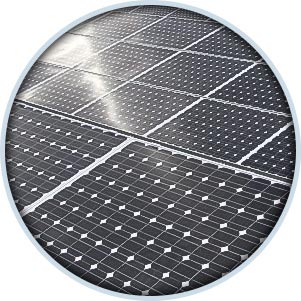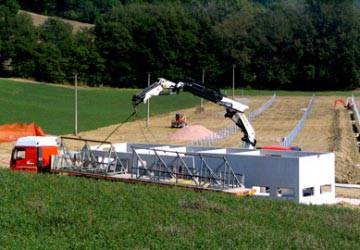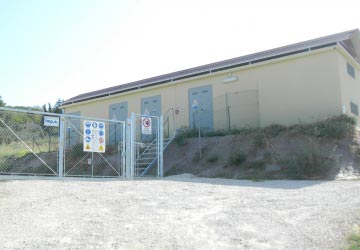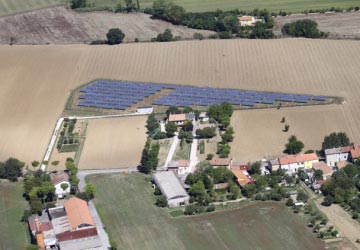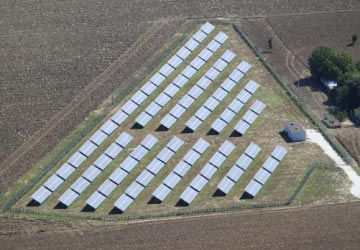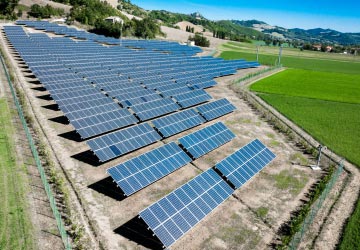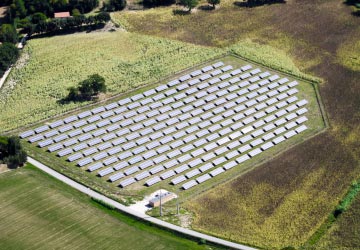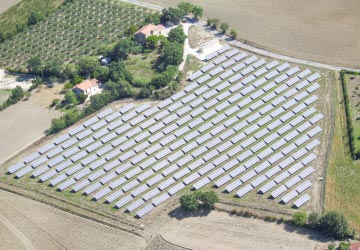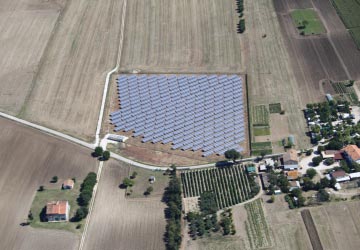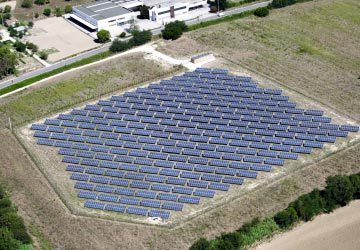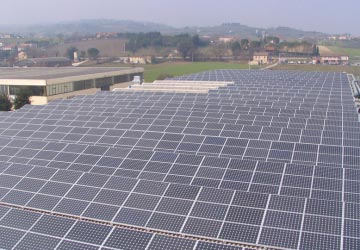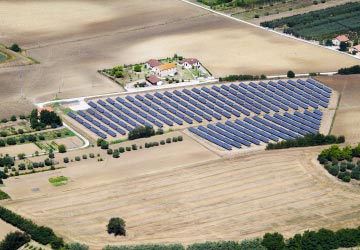Let the sun
work for you
We develop
ecological energy solutions
for a constant environmental protection
We follow our customers throughout the planning and carrying out of any idea and system typology.
Photovoltaic Systems
We employ qualified and continuously-up-to-date staff also in the sector of renewable energy, by applying national and European certificates, such as
UNI EN ISO 9001:2015 n°0056;
UNI EN ISO 14001:2015 ;
BS OHSAS 18001:2007 ;
SOA OG1, OG10, OG11, OS30.
We are at your complete disposal to provide you a free estimate for a photovoltaic system to be installed at your company or for any other kind of consultancy you may want, as photovoltaic energy is fundamental to reach important economic, ecological and ethical goals.
After a careful checking of the area,
we deal with the realization of
Roof systems
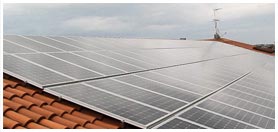
After identifying and measuring the area available, some possible shades (caused by trees or buildings) need to be taken into account in order to achieve maximum efficiency.
Ground systems
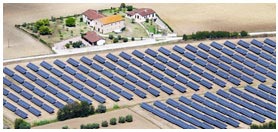
Installation on a flat or inclined surface: on a flat surface, panels are installed on trestle supports facing south, by taking into consideration hindrances such as chimneys, aerials and satellite dishes.
MT Substations

Production and installation of electrical distribution substations for the transformation of the tension supplied by MT lines to the values of supply of LT lines.
Supervision and
automation

Installation and introduction of gas- and fire-detection systems and anti-intrusion systems (including video-surveillance systems) for residential and industrial safety.
What is a photovoltaic system and how does it work?
Working principle: the photovoltaic cell.
Photovoltaic cells allow to directly convert solar radiation into electric energy, by exploiting the so-called "photovoltaic effect" which is based on the properties of some properly processed conductors (among them: silicon, which is very commonly found in nature) to produce electric energy when they are hit by solar radiation. A photovoltaic cell exposed to solar radiation acts like a current generator with a characteristic tension/current curve which basically depends on the density of solar radiation, temperature and surface.
Generally, it is a squared surface of about 100 cm² and acts like a tiny battery which produces, in typically Italian insolation conditions, 3 A (Ampere) current with a 0.5 V (Volt) tension (1.5 Watt).
The various types of solar cells
The types of photovoltaic cells vary
according to the way they are produced.
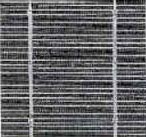 Monocrystalline cells
Monocrystalline cells
They are produced by cutting a monocrystalline bar.
The main advantage is its high yield (up to 16%).
This type of cells is very expensive because of its complicated process of production. Usually monocrystalline cells are characterised by a homogeneous blue hue.
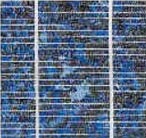 Polycrystalline – multicrystalline cells
Polycrystalline – multicrystalline cells
They are poured into blocks and then cut into small discs. Their yield is lower (10-12%) as well as their cost, though. This type of cells is characterized by an easily-recognizable pattern, due to the crystals it contains.
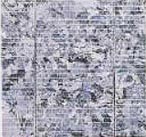 Amorphous cells
Amorphous cells
They are produced by the cathode deposition of silicon atoms on a glass plate. This type of cell produces a lower yield (about 4-8%), but it can adapt also in case of diffuse irradiance (overcast sky, etcetera). The cells thus produced are characterised by a distinctive dark hue and, moreover, they can be cut into any geometric shape (such as circular, octagonal, irregular and even convex shapes).
From the photovoltaic cell to the system
The single solar cell, which measures around 10 x 10 cm, represents the fundamental element at the basis of every photovoltaic system.
A photovoltaic module is composed of a series of connected solar cells which provide power (per module) ranging from 50 to 300 W.
In order to increase electric power, it is necessary to connect several modules: a panel is made of several modules and, similarly, a string is made of several panels.
Photovoltaic modules convert light energy into direct current electric energy in “real time”: the production of electric energy occurs simultaneously with the tapping of solar energy. For these reasons, a photovoltaic system also needs other components, in addition to a photovoltaic generator.
System types
A photovoltaic system is composed of mechanical, electrical and electronic components which tap solar energy, convert it into electric energy and make it ready to be used by consumers.
The system types are basically two:
Grid-connected systems
Stand-alone systems.
Grid-connected systems
In grid connected PV systems the energy is produced by solar panels and then converted to alternating current which can power your regular utilities, charge your accumulation system or feed energy into the National electricity network, in case it is in excess.
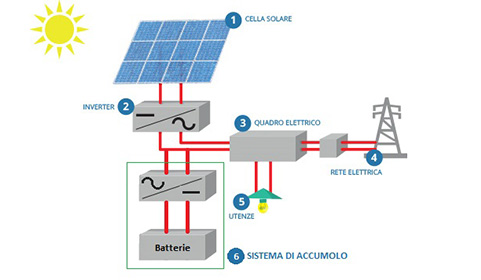
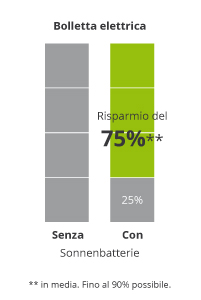
You can optimize your own consumption with the accumulation system installed into your photovoltaic equipment: by storing the energy produced by solar panels during the daytime that will exceed your instantaneous consumption so that you can use it when you need it, for example, in the evening.
 Solar cell (photovoltaic panels)
Solar cell (photovoltaic panels)
To transform solar energy into electric energy. In order to get more power, several cells are connected.
 Inverter
Inverter
It converts the direct current deriving from the modules into conventional 220 V or 400 V alternating current. This converter is absolutely necessary for the correct working of the users connected and the supply of the grid.
 Electricity board
Electricity board
The distribution of energy takes place here. If the consumption is high or there is no supply from the photovoltaic modules, the current is taken from the public grid. Otherwise, the excess photovoltaic energy is put back into the grid.
 Electricity grid
Electricity grid
Connection to the public grid of the electric company.
 Users
Users
Devices powered by the photovoltaic system grid.
Ideal solution
Grid-connected photovoltaic systems represent the ideal solution when it comes to application. In fact, all the energy produced by the system is used anyway, that is directly by the USER otherwise it is put into the electric grid which represents, as a consequence, an endless storage system.
Reduced initial costs
In addition, the lack of a local storage system allows to reduce both the initial costs and the costs of working (storage batteries, in fact, need to be replaced after some years).
In order to better understand the logic of grid-connected photovoltaic systems, just take a look at the chart displaying the energetic balance of a photovoltaic system for a typical residential consumer.
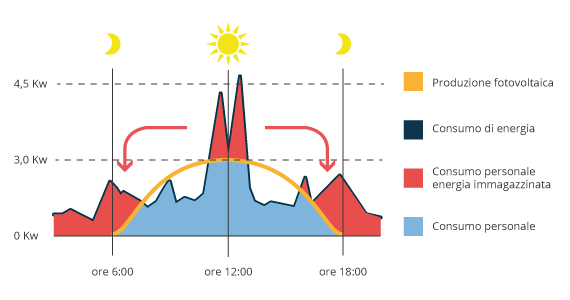
When the electrical power required by your utilities exceeds the amount of energy that the solar system can instantaneously supply, the accumulation system feeds the necessary surplus power into the utility. Therefore it does not consume the electrical power from network which means more savings for your household.
On the other hand, when the consumption level is lower then the available power produced instantaneously by the photovoltaic system, it is stored in the accumulation system (battery). In case of further power excess, produced by the solar equipment, it will be introduced into the network.
As a consequence, the correct dimensioning of a Photovoltaic System turns out to be fundamental, in order to have an energy balance.
The energy consumed needs to equal the amount of energy produced by the Photovoltaic System so that the bill is down to zero.
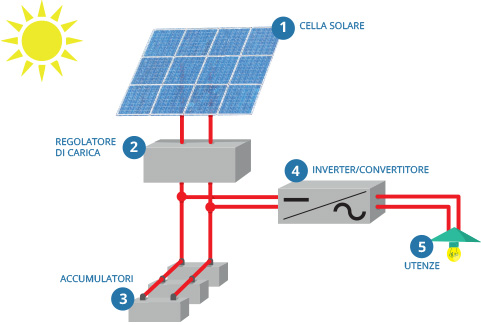
Stand-alone systems
In these systems the energy produced directly supplies electricity.
The excess energy is stored inside batteries so that it is available when the photovoltaic generator is not able to supply it.
These systems represent the most suitable solution to satisfy isolated consumers which can be suitably equipped with electric appliances working with alternating or direct current.
 Solar cell (photovoltaic panels)
Solar cell (photovoltaic panels)
To transform solar energy into electric energy. In order to get more power, several cells are connected.
 Charge regulator
Charge regulator
It is an internal device which regulates the charge and discharge of storage batteries. One of its tasks is to suspend the charge when the storage battery is full.
 Storage batteries
Storage batteries
They represent the energy store of a photovoltaic system. They supply electric energy when the modules are not able to produce it, because there is no solar irradiance.
 Inverter
Inverter
It converts direct current coming from the modules and/or storage batteries into conventional 220 V alternating current. If the device needs direct current, this component can be excluded.
 Users
Users
Devices powered by the photovoltaic system.
They are often used also in more complex systems (for example, photovoltaic systems combined with diesel power units). In this case, the photovoltaic system supplies the basic power generally used. For short-term high-consumption (or in case of emergency), the power unit is on.



